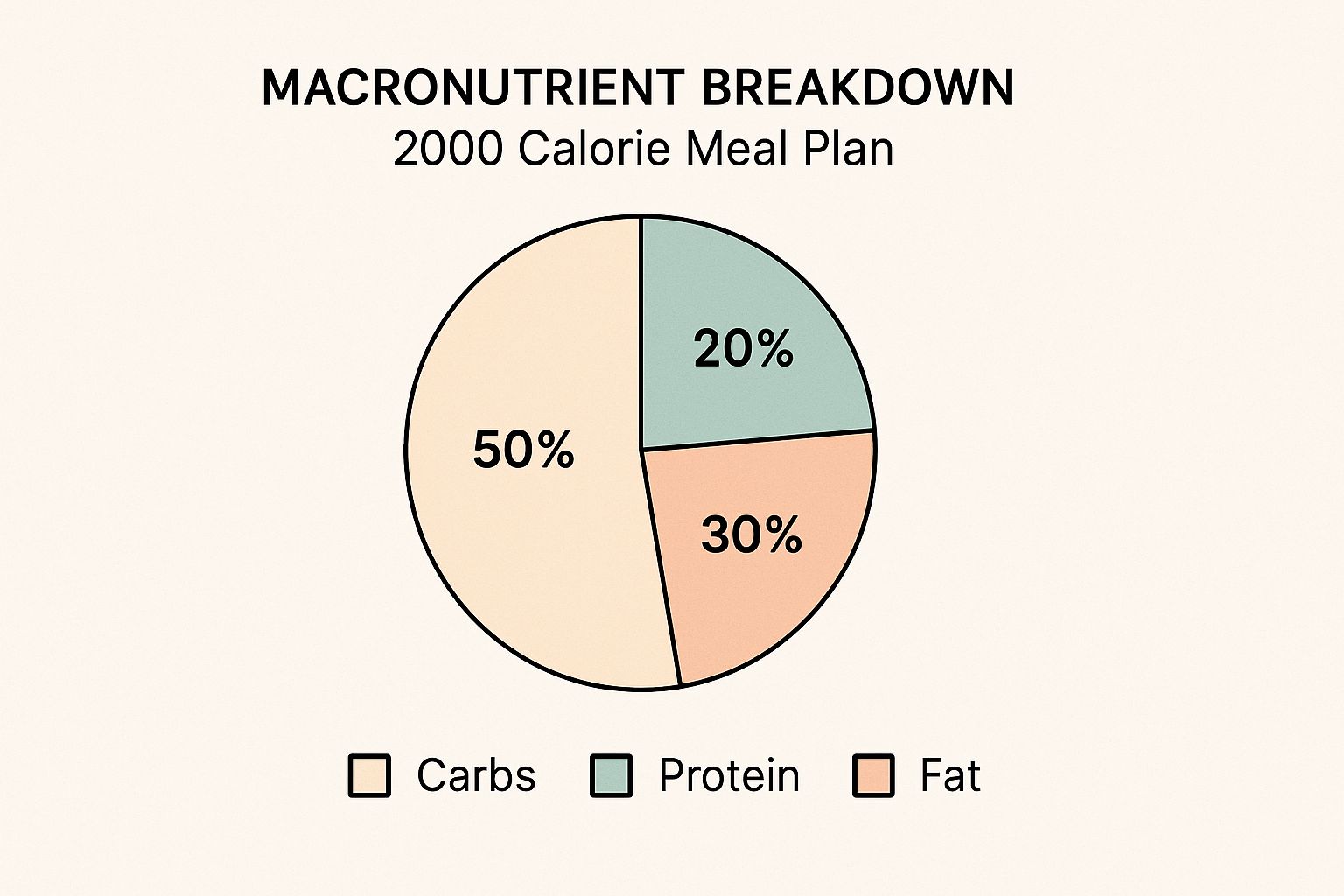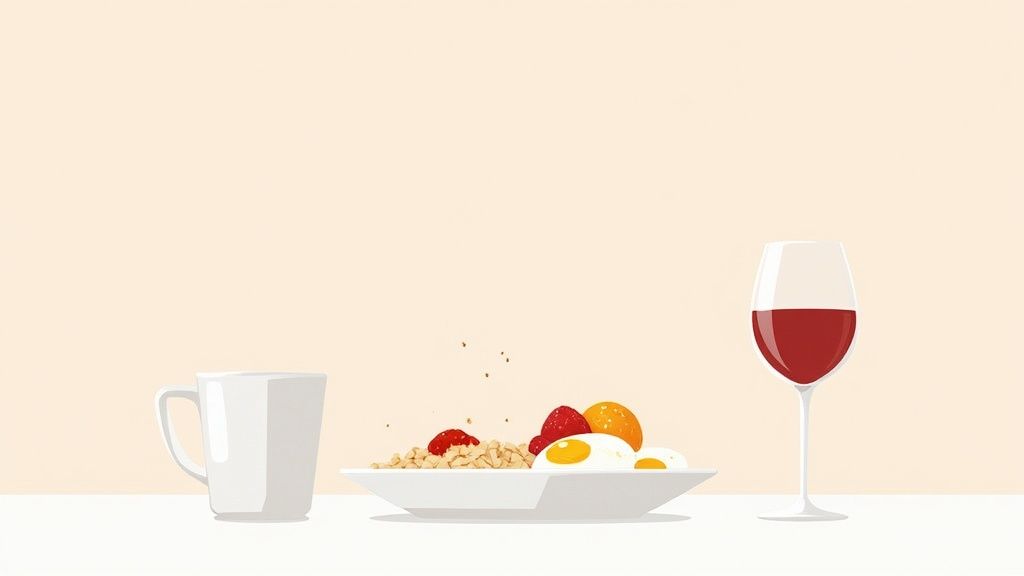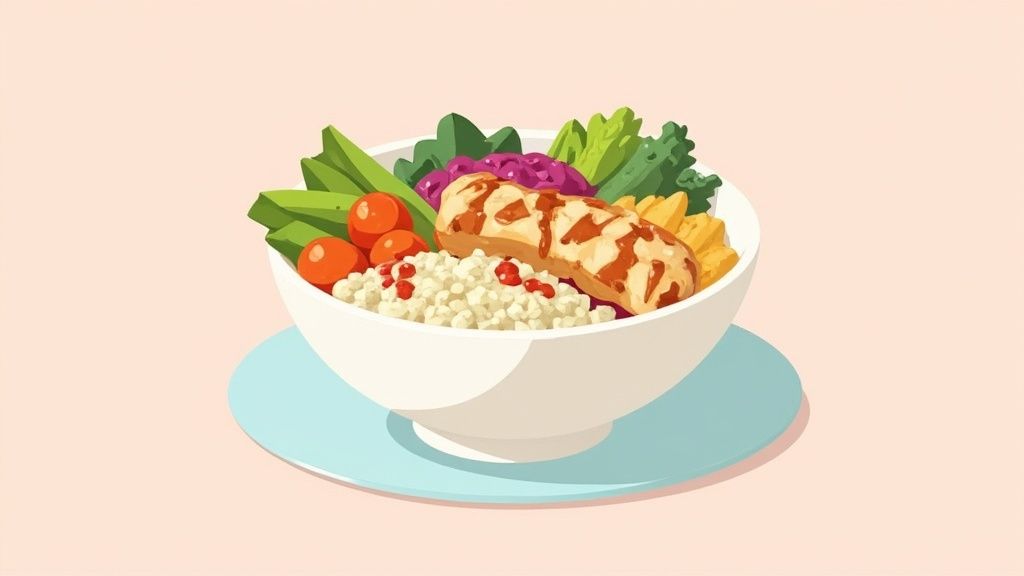A 2000 calorie meal plan is one of the most common starting points for anyone looking to get a handle on their nutrition. It’s a solid, easy-to-understand benchmark that takes the guesswork out of fueling your body, especially when you’re trying to support your home workouts or manage your weight.
Think of it as a simple blueprint you can build on, rather than a rigid set of rules you have to follow perfectly. This guide will walk you through everything you need to know, from building your plate to a sample 3-day plan you can start today.
Why 2000 Calories Is a Smart Starting Point
If you've ever felt overwhelmed by conflicting nutrition advice, you’re definitely not alone. The "2000-calorie diet" gets thrown around a lot, but rarely with any real context. Is it actually the right number for you?
Here’s the thing: 2000 calories isn't a magic number that works for everyone. Instead, it’s a brilliant reference point. It takes the abstract idea of "energy intake" and makes it tangible, helping you get a real feel for portion sizes and what a balanced day of eating actually looks like. For most people, it’s a sustainable amount of energy that supports their goals without making them feel deprived.
Where Did the 2000-Calorie Number Come From, Anyway?
This number wasn't just pulled out of thin air. It came from the USDA and FDA as a way to standardize nutritional labels on food packaging. Back in the 90s, they looked at survey data and saw that women were generally eating between 1600-2200 calories and men were in the 2000-2800 range.
So, they landed on 2000 calories as a simplified average to help us make sense of the Percentage of Daily Values (%DV) on the back of a cereal box. If you're curious, you can learn more about the history of the 2000-calorie myth and what it was originally for.
This value was never meant to be a one-size-fits-all prescription. It’s an educational tool to help you become more mindful of what you're eating.
How This Baseline Actually Helps You
Starting with this framework has some real, practical benefits, especially if you’re new to tracking your food.
- It Builds Real Awareness: You start paying attention to what you’re eating and how much. This alone is a huge step toward building a healthier relationship with food.
- It Makes Portion Control Intuitive: Once you see what a day of 2000 calories looks like, you get much better at eyeballing portions of protein, carbs, and fats. No food scale required for every single meal.
- It’s Easy to Customize: Once you get the hang of the baseline, adjusting it is simple. Have a tough workout planned? Add a protein shake or a handful of nuts. Taking a rest day? You might find you naturally eat a little less.
Ultimately, a 2000 calorie meal plan is about giving you structure, not restriction. It’s the perfect, uncomplicated launchpad for fueling your body right, crushing your at-home workouts, and building healthy habits that actually stick.
Building Your Plate: A No-Stress Guide to Balanced Eating
Forget complicated nutrition rules and tedious calorie counting for a moment. Building a healthy meal isn't about having a degree in dietetics; it's about understanding the core components that fuel your body. Here at Bare Fitness, we zero in on the essentials: protein, carbohydrates, and fats.
Each of these macronutrients, or "macros," plays a crucial role. They're the dream team for your energy, muscle recovery, and overall health. A well-designed 2000 calorie meal plan isn't about deprivation—it's about fueling your body with the right mix of these key players.
Getting a Handle on Your Macros
So, where do you start? A fantastic and sustainable baseline for a balanced diet is a split of roughly 50% carbohydrates, 30% fats, and 20% protein. This ratio provides a steady stream of energy from carbs, supports vital hormone functions with healthy fats, and gives you the protein needed to build and repair muscle.
This simple breakdown shows just how achievable a 2000-calorie day can be.

As you can see, carbohydrates take up the biggest slice of the pie. They're your body's preferred fuel source, getting you through workouts and busy days without that dreaded energy crash.
To help you visualize how this works, here’s a quick table breaking down the macros for a balanced 2000-calorie plan.
Macronutrient Breakdown for a Balanced 2000 Calorie Plan
This table is just a guide, of course. The key is to focus on getting a good mix of whole foods from each category to keep you feeling full and energized.
Forget the Scale, Use Your Hands
One of the most effective portion-control tools is one you already own—your hands. This simple, intuitive method lets you build a balanced plate whether you're at home, at a restaurant, or grabbing a quick lunch. It’s a game-changer for sticking to a 2000 calorie meal plan without the hassle of measuring every single thing.
Here’s the basic guide for eyeballing your portions:
- Protein: A serving of chicken, fish, or tofu should be about the size of your palm.
- Carbohydrates: A portion of starchy carbs like rice or potatoes is roughly the size of your cupped hand.
- Vegetables: Go big here! Aim for two open hands full of leafy greens, broccoli, or bell peppers.
- Fats: A serving of healthy fats—think a drizzle of olive oil or a small handful of nuts—is about the size of your thumb.
This isn't about being perfect; it's about being consistent. Using your hands as a guide helps you build sustainable habits that don't feel like a chore.
Key Takeaway: The goal isn't perfection; it's consistency. Using your hands as a guide helps you build sustainable habits that don't feel like a chore.
Your Foundational Grocery List
Having the right ingredients in your kitchen is half the battle won. This list isn't exhaustive, but it covers the affordable, versatile, and nutrient-packed staples that will become the foundation of your 2000 calorie meal plan.
Lean Proteins:
- Chicken or turkey breast
- Eggs
- Plain Greek yogurt
- Canned tuna or salmon
- Lentils and beans
Complex Carbs:
- Rolled or steel-cut oats
- Brown rice or quinoa
- Sweet potatoes
- Whole-grain bread
- Apples and bananas
Healthy Fats:
- Avocados
- Nuts (almonds, walnuts)
- Seeds (chia, flax)
- Olive oil
With these staples stocked in your pantry and fridge, you'll always have what you need to throw together a quick, satisfying meal that moves you closer to your fitness goals.
A 3-Day Sample Meal Plan You Can Actually Follow
Okay, enough with the theory. Let's get down to what this actually looks like on a plate. This is where the rubber meets the road—translating all those numbers and macros into real food you'll genuinely enjoy. Our goal isn't to give you a rigid, boring diet. It's to show you just how satisfying and easy a 2000 calorie meal plan can be.
The plan we’ve laid out is built on a simple philosophy: keep it straightforward and focus on real, whole foods. You won't find yourself hunting for obscure ingredients or spending hours in the kitchen. This is all about practical, everyday meals that fuel your body and support your goals.

Think of this as your starting blueprint. Don't like spinach? Swap it for kale. Not a fan of salmon? Try chicken or tofu. The idea is to give you a solid framework that you can easily adapt to what you love to eat.
Day 1: Simple Fueling
We’re kicking things off with easy wins. These are meals that come together in minutes, perfect for easing into a new routine.
- Breakfast (~440 calories): Get your day started with 3 scrambled eggs wilted with a big handful of spinach, served alongside 2 slices of whole-grain toast. The protein punch here is fantastic for keeping you full and focused all morning.
- Lunch (~500 calories): You can't go wrong with a classic grilled chicken salad. Toss a large bowl of mixed greens with 4-6 oz of pre-cooked grilled chicken breast, half an avocado, and a mix of your favorite veggies. A light vinaigrette is all you need to finish it off.
- Dinner (~520 calories): Bake a 5 oz salmon fillet and serve it with 1 cup of cooked quinoa and a hefty side of steamed broccoli. This meal is an absolute powerhouse of omega-3 fatty acids and fiber.
Snacks for Day 1:
- Mid-Morning: A single-serving container of plain Greek yogurt with a handful of fresh berries.
- Afternoon: A small handful of almonds (about 1/4 cup) paired with a crisp apple.
Day 2: Batch Cooking Basics
Today is all about working smarter, not harder. We’ll lean on some simple meal prep tricks, like using leftovers and easy-to-assemble ingredients to save you precious time.
- Breakfast (~400 calories): Overnight oats are a game-changer for hectic mornings. Before bed, just combine 1/2 cup of rolled oats, 1 cup of unsweetened almond milk, and 1 tablespoon of chia seeds in a jar. In the morning, top it with a chopped banana and you're good to go.
- Lunch (~500 calories): Let's build a hearty turkey wrap. Grab a large whole-wheat tortilla and load it up with 4-6 oz of sliced turkey breast, plenty of fresh lettuce and tomato, and a smear of hummus or mustard.
- Dinner (~490 calories): Time for a quick stir-fry. Sauté 6 oz of firm tofu or lean ground beef with a colorful mix of bell peppers and onions, and serve it all over 1 cup of brown rice.
Snacks for Day 2:
- Mid-Morning: A cup of cottage cheese with sliced bell peppers for dipping—a great savory, high-protein choice.
- Afternoon: Two hard-boiled eggs. Simple, effective fuel.
Remember, this is a flexible guide. If you're feeling extra hungry on a day you hit the gym hard, listen to your body. Adding an extra hard-boiled egg or a larger handful of nuts is an easy and smart adjustment.
Day 3: Smoothie and Simple Swaps
On our final day, we'll show you how to use a protein smoothie for ultimate convenience and how to build incredibly satisfying meals around plant-based proteins.
- Breakfast (~500 calories): A power smoothie is the perfect on-the-go meal. Blend 1 scoop of protein powder, 1 banana, a big handful of spinach, 2 tablespoons of peanut butter, and about 1.5 cups of almond milk until smooth.
- Lunch (~450 calories): Nothing beats a comforting bowl of hearty lentil soup. A generous 2-cup serving is packed with amazing fiber and plant-based protein. Pair it with a slice of whole-grain bread for dipping.
- Dinner (~540 calories): Grill or pan-sear 6 oz of shrimp and serve it with a large baked sweet potato and some roasted asparagus. This meal feels indulgent but is light and incredibly filling.
Snacks for Day 3:
- Mid-Morning: A large pear with a small handful of walnuts.
- Afternoon: A single-serving bag of baby carrots with 2-3 tablespoons of hummus.
Hopefully, this 3-day example gives you the confidence to see that a 2000 calorie meal plan is not only manageable but can also be delicious. It all comes down to focusing on good, whole foods and keeping your prep simple. You've got this.
Making Your Meal Plan Work for Your Real Life
A meal plan on paper is one thing. Actually making it work with a crazy schedule, workouts, and a social life? That's a whole different ball game. The goal isn't to bend your life to fit a rigid diet. It's about making a healthy framework, like a 2000 calorie meal plan, support the life you're already living. A little bit of planning and a lot of flexibility are your secret weapons here.

For this to stick, it has to reduce your stress, not add to it. One of the best ways to do that is with some simple, budget-friendly meal prep. You don't need to block off your entire Sunday for some marathon cooking session; just get the basics sorted.
Smart Prep for a Busy Week
Batch cooking is a lifesaver. Forget making entire, complicated meals. Just focus on prepping the components.
- Cook a big batch of grains: A pot of quinoa or brown rice can serve as the foundation for half your meals all week.
- Prep your proteins: Grill up a few chicken breasts, hard-boil a dozen eggs, or bake a tray of tofu. Having these ready to go is a game-changer.
- Chop your veggies: Wash and slice up some bell peppers, broccoli, and carrots. They’ll be ready to grab for a quick snack or to toss into a stir-fry on a busy night.
The key is progress, not perfection. If all you manage to do is cook some rice and chop a few veggies, that's a huge win that will save you time and decision fatigue later.
This simple prep work means you can throw together a balanced meal in minutes instead of starting from scratch every single time.
Adapting Your Plan for Different Lifestyles
Let’s be real: your nutritional needs are unique, and a one-size-fits-all plan is doomed from the start. A plan has to be flexible to survive.
If you're plant-based, hitting your protein goals is totally doable. You just need to be intentional. Make sure you're incorporating plenty of lentils, beans, tofu, and tempeh. A hearty lentil soup or a tofu scramble can easily stand in for their meat-based cousins, keeping you full and energized.
Going out with friends doesn't have to throw you off track, either. Just scan the menu for lean proteins and veggies—think grilled fish or a big salad with chicken. Most restaurants are more than willing to make small changes, like putting the dressing on the side or swapping fries for steamed vegetables. All you have to do is ask.
And don't forget to factor in your activity level. On days you hit the gym hard, your body is going to crave more fuel. Adding a small, protein-rich snack like Greek yogurt or a handful of almonds is a smart move. On rest days, you might not feel as hungry. Listen to your body—it's usually telling you what it needs.
Finally, we have to talk about the cost, because that's a huge real-world factor. The price of sticking to a balanced 2000 calorie meal plan can vary wildly depending on where you live. It might be around £6.47 per day in London but only £1.95 in India, which shows just how much economics can play a role in nutrition. Discover more insights about diet costs around the world to see the full picture. By building your plan around affordable staples like oats, beans, and seasonal vegetables, you can keep both your body and your bank account happy.
How to Track Progress and Stay Motivated
Starting a new meal plan feels great, but let's be real—sticking with it is where the real work (and the real results) begins. This isn't just about following a 2000 calorie meal plan for a week. It's about building a healthier relationship with food that truly supports your goals long-term.
The first thing we tell our members? Get your head away from the scale. Seriously. While it’s one piece of the puzzle, it doesn't even come close to telling the whole story. Instead, let's focus on the wins you can actually feel.

Tune Into Your Body, Not Just the Scale
Your body is giving you constant feedback. The trick is learning to listen to it, which is a much more reliable indicator of success than the daily ups and downs of the scale.
Start looking for these positive signs:
- More Energy: Do you still hit that 3 PM slump, or are you feeling more alert and ready for your workouts?
- Better Sleep: Are you waking up feeling genuinely rested? That’s a huge win.
- Clothes Fit Differently: How do those favorite jeans feel? A little more comfortable? That's progress.
- Improved Mood: Have you noticed you’re a bit more even-keeled and positive? Food has a huge impact on that.
These "non-scale victories" are the true markers that show your new habits are genuinely improving your life.
Don’t let one "off" day derail a week of great choices. Progress isn’t about perfection; it’s about consistency. Acknowledge it, learn from it, and get right back on track with your next meal.
Use Journaling to Build Awareness
A simple notebook might just become your most valuable tool on this journey. It’s not about meticulously tracking every single bite, but about connecting what you eat with how you feel. You'd be surprised what you can uncover with just a few notes each day.
Try jotting down answers to these questions before bed:
- When did I feel most energized today? And what had I eaten an hour or two before?
- Did I eat when I wasn't truly hungry? If so, what was going on? Was I bored, stressed, or just eating out of habit?
- What's one non-scale victory I can celebrate today? (Maybe you opted for a healthy snack or finally drank enough water).
This isn't an exercise in judgment—it's about getting curious. Over time, you'll start to see patterns and gain a much deeper understanding of your own hunger cues. This is how a 2000 calorie meal plan stops feeling like a rigid set of rules and starts feeling like an intuitive, supportive way of eating. You’ve got this.
Got Questions About the 2000-Calorie Plan? You're Not Alone.
Starting a new nutrition plan always brings up a few questions. That's a good thing! It means you're engaged and thinking critically about what works for you. Let's tackle some of the most common ones we hear about the 2000 calorie meal plan so you can get started with total confidence.
Can I Actually Lose Weight Eating 2000 Calories a Day?
For a lot of people, the answer is a resounding yes. A 2000 calorie target often creates the perfect, gentle calorie deficit—enough to see steady, sustainable weight loss without feeling like you're starving. Think of it as a fantastic starting point.
Of course, everyone is different. Your specific needs will hinge on your current weight, how active you are, and your unique metabolism. Give this plan a solid try for a few weeks. If you’re feeling energized and the scale is moving in the right direction, you've hit a sweet spot. If not, it's easy to make a few small tweaks.
What if I’m Still Hungry on 2000 Calories?
This is a super common concern, and it usually has less to do with the number of calories and more to do with the type of food you're eating. If you find your stomach rumbling all day, it's time to look at the composition of your meals.
- Pump Up the Protein and Fiber: These two are your best friends when it comes to feeling full and satisfied. Make sure every single meal has a good source of both. We're talking chicken and broccoli, a hearty lentil soup, or Greek yogurt topped with berries and chia seeds.
- Drink Up: It's so easy to mistake thirst for hunger. Before you grab another snack, try drinking a big glass of water and wait 15 minutes. You might be surprised.
- Meal Timing Matters: Spreading your calories out every 3-4 hours helps keep your blood sugar from crashing, which is often what triggers those intense, can't-ignore hunger pangs.
And hey, if you just finished a grueling workout, your body is going to need a little extra fuel to recover. An extra protein-packed snack is a smart, necessary choice.
Do I Have to Say Goodbye to All My Favorite Foods?
Absolutely not. Let's be clear: any plan that makes you miserable is a plan that's doomed to fail. At Bare Fitness, we’re all about balance, not brutal restriction. Sustainability is the name of the game.
A healthy lifestyle is built on what you do consistently, not what you do perfectly. Enjoying the foods you love is a non-negotiable part of a balanced, happy life.
We're big fans of the 80/20 rule. It’s simple: fill your diet with nutrient-dense, whole foods about 80% of the time. The other 20%? That’s for the pizza, the ice cream, or whatever treats you truly enjoy. When you plan for these foods, you can savor them guilt-free and stay on track for the long haul.
Ready to pair your new nutrition plan with workouts that actually fit your life? At Bare Fitness, we specialize in effective, equipment-minimal fitness solutions designed for real people. Explore our programs and get started today!



















